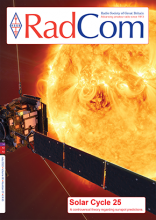New Paradigm for Solar Cycle Measurement and Prediction Featured in RadCom
New Paradigm for Solar Cycle Measurement and Prediction Featured in RadCom

As Solar Cycle 25 begins, amateur radio operators look forward to the return of the exciting propagation conditions associated with solar maximum. The classic paradigm for solar cycle prediction is based on an 11-year sinusoidal pattern of sunspot numbers, with an official NASA-NOAA "consensus" prediction coming from a panel of experts evaluating an ensemble of different types of models. However, the underlying solar cycle mechanism is still not well understood and this consensus prediction can fall short. Scott McIntosh at the U.S. National Center of Atmospheric Research (NCAR) and his team have recently published a new method for predicting the time and amplitude of solar maximum, based on changes in the observed magnetic polarity in different regions of the sun. This new method predicts a stronger Solar Cycle 25 than the NASA-NOAA "consensus" prediction. HamSCI member Frank Howell K4FMH teams up with Dr. McIntosh to review this new methodology and its potential impacts on how we think about solar cycle predictions in a two-part article series currently featured on the cover of RSGB's RadCom magazine. More information can also be found at Frank's blog.
